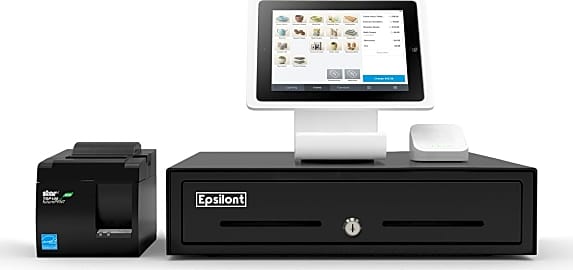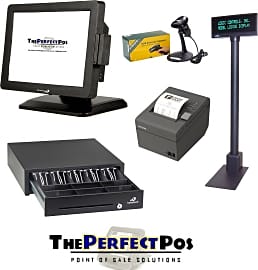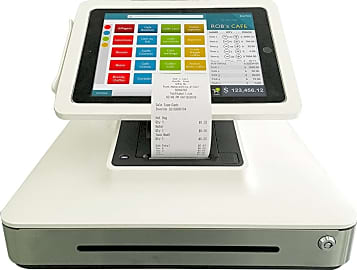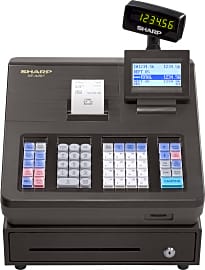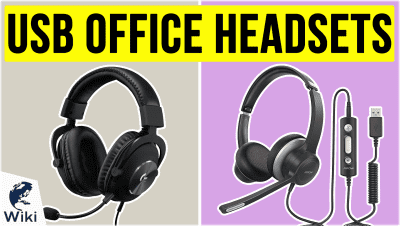The 7 Best Cash Registers

This wiki has been updated 39 times since it was first published in February of 2015. Whether you're a mom and pop shop or a burgeoning multi-state franchise with several locations, you can keep your business running smoothly and the staff on target with one of these handy cash registers. Depending on the budget and size of an operation, you can choose from various features, including easy-to-read alphanumeric displays, locking cash drawers, and sophisticated point-of-sale systems. When users buy our independently chosen editorial recommendations, we may earn commissions to help fund the Wiki.
Editor's Notes
July 09, 2021:
This update saw the removal of a Square unit that's just a credit card reader and doesn't have anywhere for cash. A pair of outdated Casio models also got bumped. The Sharp XEA207 is one addition, and it replaces the more costly and hard-to-find XEA407, which differs mostly in having a higher PLU capacity and dual printers. We also elevated the Star Micronics TSP143III to the #2 spot because it performs very well despite its mid-range cost. For a moderately priced option with an integrated keyboard, consider the highly durable Sam4S SPS-340 Electronic.
March 23, 2020:
There was a bit of room left on our last ranking that we were able to fill this time with some excellent offerings, including the Clover POS Station and the Square 0373, both of which are decidedly modern setups with touchscreen interfaces and interactive customer displays. The Clover won out over the Square mainly thanks to its included cash drawer, but many users are going to be offering goods in places like flea markets or street fairs where cash is used somewhat less often, and they may even be able to get away with a wholly card-based payment system.
At first glance, the Datio Base Station and the Epsilont Square Bundle may seem like steals, but these are really just excellent bases for systems that will still require you to use your own iPad, and that can significantly add to their investment.
The Aldelo Pro remains one of the best options for restaurants and similar businesses that need deep, comprehensive menus in which orders for goods can be adjusted on the fly (hold the mayo, for example). And if you're working in an environment where you want your register to make as little noise as possible, or you just don't like the clickety clack of traditional keys and also don't want to deal with a touchscreen, the Sam4S SPS-340 Electronic offers a programmable flat keyboard with 150 places you can set to ring up specific goods and prices.
Keep The Customers Flowing
For additional security, many cash registers require the use of a numeric password or a physical key to open the cash drawer itself.
Let's assume that you're just about ready to open up your brand new business. You've got that great corner building location on the ground floor that is sure to bring in droves of customers. You've got products to sell, you're almost done hiring the staff, and you've brought in contractors and painters to make sure the place is up to snuff and ready to serve. The only thing you need now is an efficient way to get customers through the line as quickly as possible when they're done shopping and ready to pay for what they've picked out. Additionally, the equipment you use must be reliable and fast enough to deliver, particularly during the busy season that comes all too quickly around Christmas time. For that reason, you're going to need an efficient cash register to make sales quickly, generate accurate receipts, and keep your customers coming back.
Also referred to as a till, a cash register is either a mechanical or electronic device for recording and calculating business transactions. The cash register is typically attached to a money drawer for convenient cash storage, while also connected to a printer for quick receipt creation. This ensures that both you and your customers have a record of every purchase.
Cash registers are commonly attached to debit and credit card terminals, which come in very handy in places like supermarkets or department stores, as electronic transactions are both quick and easy to automate.
To take this a step further, many businesses today leverage computers with point of sale software capable of reading scales and product bar codes, while also allowing the customer to use a touchscreen interface to complete his/her transaction. This happens in conjunction with a cash register in many cases.
Many electronic cash registers feature a No Sale key, which has a primary function of opening the cash drawer, printing a receipt, and maintaining a record that the drawer was opened in the register's log. For additional security, many cash registers require the use of a numeric password or a physical key to open the cash drawer itself. This limits the number of potential staff having access to a day's cash profits and prevents theft.
When the register prints a record of each instance the drawer has been opened, it successfully maintains a record of the agent or owner's consent to open the drawer in the first place. That said, the no-sale receipt makes it possible to track cash register activity at a given time. Such receipts often record the name of the cashier logged into the point-of-sale system at the time the drawer was opened.
For large businesses like grocery chains, self-checkout terminals are used and allow the customer to scan their items into the machine using an item's bar code, while bagging their groceries without the need for a cashier to be present. While some grocery stores offer this type of checkout as a convenience, a majority of customers still prefer to complete a transaction with a human being around just in case something goes wrong with the machine or if they plan to use cash that requires a register.
A Brief History Of The Cash Register
Following the American Civil War, the first working mechanical cash register was patented in January 1883 by Dayton, Ohio saloon owner James Ritty and John Birch. This first machine was originally referred to as Ritty's Incorruptible Cashier. Its main reason for use was to prevent employee embezzlement. The machine used metal taps with pressed-in denominations to represent the amount of a particular sale. The machine also featured a manual bell to ring up a transaction as well as a mechanical adder designed to sum up the cash value of all the machine's key presses during a given business day.
This first machine was originally referred to as Ritty's Incorruptible Cashier.
The earliest mechanical cash registers did not print receipts. This forced the employee to ring up every single transaction on the device and press a total key that would prompt the machine's bell to ring and alert the manager that a sale had just taken place.
In 1884, John H. Patterson developed additional improvements to Ritty's design of the cash register by incorporating a paper roll to record sales transactions, leading to the establishment of internal and external bookkeeping services.
In 1906, inventor Charles F. Kettering designed the first cash register with an electric motor. Throughout the remainder of the twentieth century, a major focus on the development of the cash register was to improve its level of security, automation, and ease of use. Today, cash registers have the power to function as standalone computers capable of scanning thousands of items, processing credit cards, and offering touch screen interfaces to maximize business efficiency.
Choosing The Most Efficient Cash Register
Speed, accuracy, and options are most important by today's standards when investing in a cash register for your business. If you deal with a lot of customers day in and day out, having the ability to use a touchscreen interface will definitely speed things along, while keeping your records safe and up to date as your staff completes transactions. Many point-of-sale systems also include a thermal receipt printer, which one must consider a necessity for transaction records.
Some cash registers also interact with mobile devices like the iPhone or iPad, which is perfect for small businesses and quick sales.
Finally, for the benefit of your checkout staff, be certain the keyboard interface of the cash register is comfortable to use, especially if an employee will be standing in front of the device for extended periods of time.


